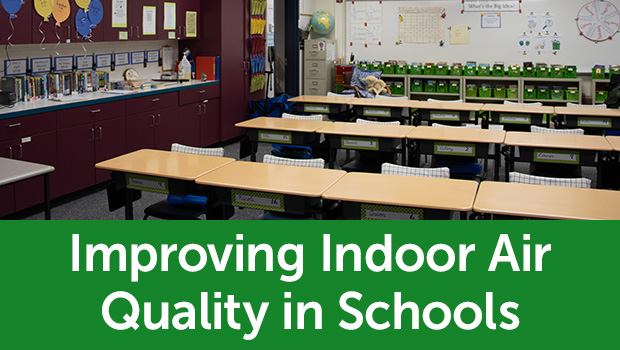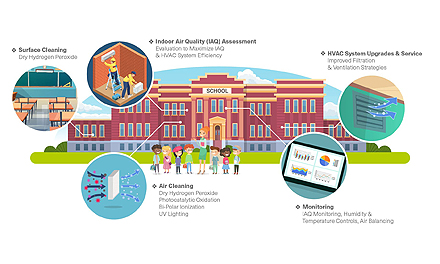To improve indoor air quality in schools, focus on optimizing HVAC systems, using natural ventilation, and adding portable air cleaners. Taking these steps can help reduce air pollutants and create a healthier learning environment for students and staff.
By controlling pollution sources, ensuring adequate ventilation, and employing air cleaning technologies, schools can significantly enhance their indoor air quality. Additionally, strategies such as opening windows and doors where safe, using air purifiers, and maintaining ventilation systems can all contribute to better air quality in educational settings.
Implementing these practices can lead to positive impacts on student health, productivity, and overall well-being.

Credit: cea.org
Importance Of Indoor Air Quality In Schools
Poor indoor air quality in schools can have a significant impact on the health and academic performance of students and staff. Exposure to pollutants such as allergens, mold, and volatile organic compounds (VOCs) can lead to respiratory problems, allergies, and other health issues. These health concerns can result in frequent absences and reduced productivity.
Furthermore, studies have shown that poor indoor air quality can affect students’ ability to concentrate and perform well academically. Research indicates that improved ventilation and air filtration systems in schools can lead to higher test scores and improved cognitive abilities.
The cost of poor indoor air quality is not just limited to the health and academic performance of individuals. It can also result in increased healthcare costs and the need for frequent maintenance and repairs of HVAC systems.
To improve indoor air quality in schools, measures such as optimizing mechanical ventilation systems, using air purifiers, practicing integrated pest management, and effectively cleaning and maintaining the environment are essential. Additionally, opening windows to allow natural ventilation can help circulate fresh air.
Table: Strategies to Improve Indoor Air Quality in Schools
| Strategies | Description |
|---|---|
| Optimize or Upgrade Mechanical Ventilation (HVAC) System | Ensure proper functioning and efficiency of the HVAC system to circulate clean air. |
| Add Portable Air Cleaning Devices (PACs) | Use PACs to remove airborne pollutants and improve air quality in specific areas. |
| Practice Integrated Pest Management | Implement methods to control pests without the use of harmful chemicals. |
| Effectively Clean and Maintain | Regularly clean and maintain the school environment to prevent the accumulation of dust, mold, and other contaminants. |
| Open Windows for Natural Ventilation | Allow fresh air to circulate by opening windows whenever possible. |
| Provide Quality HVAC | Ensure the HVAC system is of high quality and suitable for the size of the school. |

Credit: www.youtube.com
Factors Affecting Indoor Air Quality In Schools
Factors Affecting Indoor Air Quality in Schools
Ventilation Systems: Enhancing ventilation helps in circulating fresh air and reducing indoor air pollutants. Regular maintenance of ventilation systems is crucial for optimal performance.
Building Materials: Choose eco-friendly building materials to reduce harmful emissions. Ensure proper sealing to prevent air leaks that can compromise indoor air quality.
Cleaning and Maintenance Practices: Implementing regular cleaning schedules and using environmentally friendly cleaning products can significantly improve indoor air quality in schools.
Strategies For Improving Indoor Air Quality
Improving indoor air quality in schools is crucial for creating a healthy learning environment. Strategies like optimizing ventilation systems, adding portable air cleaning devices (PACs), and promoting natural ventilation through open doors and windows can significantly reduce air pollutants in schools, ensuring a safe and comfortable atmosphere for students and staff.
| Optimizing Mechanical Ventilation Systems | Upgrade or maintain HVAC systems to ensure proper ventilation. |
| Utilizing Natural Ventilation | Open windows and doors to allow fresh air circulation. |
| Implementing Air Cleaning Devices | Use portable air purifiers to reduce indoor air pollutants. |
Role Of Epa In Improving School Air Quality
Role of EPA in Improving School Air Quality:
The EPA plays a crucial role in improving indoor air quality in schools. They provide valuable resources such as the IAQ Tools for Schools Action Kit which helps ensure good air quality in educational institutions. This kit is designed to assist school facility managers, officials, teachers, staff, and health professionals in creating a healthy and comfortable learning environment for students.
Promoting Healthy Learning Environment:
The IAQ Tools for Schools Action Kit provides practical steps and guidance on various measures, including:
- Optimizing or upgrading the mechanical ventilation (HVAC) system.
- Opening windows and doors for natural ventilation.
- Adding portable air cleaning devices (PACs) to filter the air.
- Implementing integrated pest management.
- Practicing aggressive source control to minimize pollutants.
- Effectively cleaning and maintaining the school environment to prevent mold and moisture.
By following these recommendations and taking proactive measures, schools can significantly improve indoor air quality and create a healthier environment for students, teachers, and staff.
Impact Of Indoor Air Quality On Educational Outcomes
Improving indoor air quality in schools can have a significant impact on educational outcomes. By reducing absenteeism and enhancing academic performance, schools can create a healthier environment for students and staff. Implementing strategies such as optimizing ventilation systems and adding portable air cleaning devices can help control sources of pollution and improve overall air quality. Additionally, improving ventilation by opening windows and utilizing natural airflow can contribute to a healthier indoor environment. It is also important to consider using air purifiers and removing harmful building materials to further enhance air quality. By taking proactive steps to improve indoor air quality, schools can create a conducive environment that promotes better learning outcomes and overall well-being.

Credit: huntontrane.com
Frequently Asked Questions On How To Improve Indoor Air Quality In School?
How Can We Improve Air Quality In Schools?
To improve air quality in schools, optimize or upgrade your mechanical ventilation system. Open doors and windows for natural ventilation. Consider adding portable air cleaning devices. Use air purifiers and ventilation systems to reduce air pollutants. Remove harmful building materials and implement green practices.
These steps help create a healthier learning environment.
What Are 3 Strategies To Improve Indoor Air Quality?
To improve indoor air quality, use air purifiers, maintain ventilation systems, and control sources of pollution.
How Do You Make School Air Not Affect You?
To minimize the impact of school air on you, use air purifiers, improve ventilation systems, opt for whiteboards over chalkboards, and go green.
How Do You Fix School Air?
To fix school air, improve ventilation by opening windows and doors whenever safe. Use portable air cleaning devices and weatherstripping. Remove harmful building materials and opt for green alternatives. Additionally, consider upgrading the HVAC system. These steps can help improve indoor air quality in schools.
Conclusion
Improving indoor air quality in schools is crucial for creating a healthy learning environment for students and staff. By implementing low-cost strategies such as controlling pollution sources, ensuring adequate ventilation, and using air cleaning devices, schools can significantly improve air quality.
Other steps, such as using air purifiers, opting for whiteboards instead of chalkboards, and implementing proper ventilation systems, can also contribute to better air quality. By taking these measures, schools can promote the well-being and productivity of everyone in the educational community.
Rakib Sarwar is a Registered Pharmacist and a reputed health and wellness blogger. He has a great interest in Air purifiers.